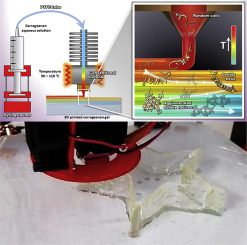当前位置:
X-MOL 学术
›
Food Hydrocoll.
›
论文详情
Our official English website, www.x-mol.net, welcomes your
feedback! (Note: you will need to create a separate account there.)
3D printing in situ gelification of κ-carrageenan solutions: Effect of printing variables on the rheological response
Food Hydrocolloids ( IF 11.0 ) Pub Date : 2019-02-01 , DOI: 10.1016/j.foodhyd.2018.08.010 I. Diañez , C. Gallegos , E. Brito-de la Fuente , I. Martínez , C. Valencia , M.C. Sánchez , M.J. Diaz , J.M. Franco
Food Hydrocolloids ( IF 11.0 ) Pub Date : 2019-02-01 , DOI: 10.1016/j.foodhyd.2018.08.010 I. Diañez , C. Gallegos , E. Brito-de la Fuente , I. Martínez , C. Valencia , M.C. Sánchez , M.J. Diaz , J.M. Franco

|
Abstract This work reports a successful 3D printing-based in situ temperature-induced gelification procedure of κ-carrageenan aqueous dispersions. 3D printer was modified to handle low viscosity fluid feeding and more efficiently distribute ambient air at room temperature causing forced convection to accelerate the cooling of the printed layer. Thus, obtained gel samples, containing 30 mg/g κ-carrageenan in water, showed self-sustaining capability and a rheological response comparable with a reference conventionally prepared gel. Moreover, the effect of main printing variables, such as temperature of the hotend, printing speed and layer height, on the linear viscoelastic response of the gels was analysed by application of the response surface methodology (RSM). In general, gel strength linearly increases by decreasing printing speed and layer height whereas not noticeable improvement in gel strength was achieved by applying hotend temperatures above 80–85 °C. Based on the results obtained from this analysis, an optimisation method is proposed to minimise the temperature and time needed to 3D print a gel with pre-set rheological properties. Overall, this study demonstrates that it is possible to generate in situ 3D printed gel materials with potential uses in food and pharmaco-nutrition, without the aid of reactive additives or initiators, and using a facile protocol.
中文翻译:

κ-角叉菜胶溶液的 3D 打印原位凝胶化:打印变量对流变响应的影响
摘要 这项工作报告了一种成功的基于 3D 打印的 κ-角叉菜胶水分散体的原位温度诱导凝胶化过程。3D 打印机经过改进,可以处理低粘度流体进料,并在室温下更有效地分配环境空气,从而产生强制对流以加速打印层的冷却。因此,所获得的凝胶样品,在水中含有 30 mg/g κ-角叉菜胶,显示出与常规制备的参考凝胶相当的自持能力和流变响应。此外,通过应用响应面方法 (RSM) 分析了主要印刷变量,如热端温度、印刷速度和层高,对凝胶的线性粘弹性响应的影响。一般来说,凝胶强度通过降低印刷速度和层高而线性增加,而通过施加高于 80-85°C 的热端温度,凝胶强度没有明显提高。基于从该分析获得的结果,提出了一种优化方法,以最大限度地减少 3D 打印具有预设流变特性的凝胶所需的温度和时间。总体而言,这项研究表明,无需借助反应性添加剂或引发剂,并使用简便的方案,就可以生成具有食品和药物营养潜在用途的原位 3D 打印凝胶材料。提出了一种优化方法,以最大限度地减少 3D 打印具有预设流变特性的凝胶所需的温度和时间。总体而言,这项研究表明,无需借助反应性添加剂或引发剂,并使用简便的方案,就可以生成具有食品和药物营养潜在用途的原位 3D 打印凝胶材料。提出了一种优化方法,以最大限度地减少 3D 打印具有预设流变特性的凝胶所需的温度和时间。总体而言,这项研究表明,无需借助反应性添加剂或引发剂,并使用简便的方案,就可以生成具有食品和药物营养潜在用途的原位 3D 打印凝胶材料。
更新日期:2019-02-01
中文翻译:

κ-角叉菜胶溶液的 3D 打印原位凝胶化:打印变量对流变响应的影响
摘要 这项工作报告了一种成功的基于 3D 打印的 κ-角叉菜胶水分散体的原位温度诱导凝胶化过程。3D 打印机经过改进,可以处理低粘度流体进料,并在室温下更有效地分配环境空气,从而产生强制对流以加速打印层的冷却。因此,所获得的凝胶样品,在水中含有 30 mg/g κ-角叉菜胶,显示出与常规制备的参考凝胶相当的自持能力和流变响应。此外,通过应用响应面方法 (RSM) 分析了主要印刷变量,如热端温度、印刷速度和层高,对凝胶的线性粘弹性响应的影响。一般来说,凝胶强度通过降低印刷速度和层高而线性增加,而通过施加高于 80-85°C 的热端温度,凝胶强度没有明显提高。基于从该分析获得的结果,提出了一种优化方法,以最大限度地减少 3D 打印具有预设流变特性的凝胶所需的温度和时间。总体而言,这项研究表明,无需借助反应性添加剂或引发剂,并使用简便的方案,就可以生成具有食品和药物营养潜在用途的原位 3D 打印凝胶材料。提出了一种优化方法,以最大限度地减少 3D 打印具有预设流变特性的凝胶所需的温度和时间。总体而言,这项研究表明,无需借助反应性添加剂或引发剂,并使用简便的方案,就可以生成具有食品和药物营养潜在用途的原位 3D 打印凝胶材料。提出了一种优化方法,以最大限度地减少 3D 打印具有预设流变特性的凝胶所需的温度和时间。总体而言,这项研究表明,无需借助反应性添加剂或引发剂,并使用简便的方案,就可以生成具有食品和药物营养潜在用途的原位 3D 打印凝胶材料。











































 京公网安备 11010802027423号
京公网安备 11010802027423号